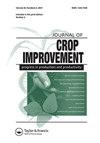豇豆(Vigna unguiculata(L.)Walp)基因型对斑点圆蚧的抗性
IF 1.5
Q3 AGRONOMY
引用次数: 0
摘要
摘要斑胼胝体(Callosobruchus maculatus)是一种重要的田间害虫,对储藏农产品造成接近100%的损失。本研究旨在评估豇豆基因型对黄斑弧菌侵染的抗性。采用无选择试验对13个高产豇豆高级选育品系和3个发布品种(帕迪图雅、柯克豪本加和旺卡)进行了评价。实验采用完全随机设计,在实验室条件下重复4次。收集了平均每粒卵数(MEPS)、初羽化天数(DFE)、成虫羽化率(ABE)、失重率(PWL)、种子损害率(PSD)和平均发育期(MDP)的数据。计算多比易感指数(Dobie’s susceptibility index, DSI)并将基因型划分为耐药型和易感型。除DFE和MDP外,各基因型间性状差异显著。IT13K-1070-2的MEPS、ABE、PWL和PSD最低。黄斑弧菌在柯柯斯、本加和旺卡发育最好,ABE较高。实验结束时,王科的种子损坏率为100%。根据DSI评分,发现IT13K-1070-2具有中等抗性;其余基因型易感。易感基因型中,IT10K-817-3、IT07K-303-1、SARI-2-50-80、SARI-3-11-100、IT10K-837-1、IT13K-1424-12和SARVX-09-004的PWL均小于16%,表明对毛毛鼠侵染具有耐受性。DSI与ABE (r = 0.81)、PSD (r = 0.93)、PWL (r = 0.79)呈显著正相关。DSI与最终种子重呈显著负相关(r = - 0.83)。IT13K-1070-2在豇豆育种中可作为抗豇豆糙肠病的有效来源,也可作为栽培品种释放。本文章由计算机程序翻译,如有差异,请以英文原文为准。
Resistance to Callosobruchus maculatus among cowpea (Vigna unguiculata (L.) Walp) genotypes
ABSTRACT Callosobruchus maculatus is an important field-to-store pest that causes close to 100% losses in stored produce. This study aimed at assessing the resistance of cowpea genotypes to C. maculatus infestation. Thirteen cowpea advanced breeding lines pre-selected on the basis of their high grain yield, and three released varieties (Padi-tuya, Kirkhouse Benga and Wangkae) were evaluated in a no-choice experiment. The experiment was laid out in a completely randomized design with four replications under laboratory conditions. Data were collected on mean number of eggs per seed (MEPS), days to first emergence (DFE), adult bruchid emergence (ABE), percentage weight loss (PWL), percentage seed damage (PSD) and median development period (MDP). Dobie’s susceptibility index (DSI) was computed and used to classify the genotypes as resistant or susceptible. Significant differences were found among the genotypes for the measured traits, except for DFE and MDP. IT13K-1070-2 had the lowest MEPS, ABE, PWL and PSD. C. maculatus, with high ABE, developed best on Kirkhouse Benga and Wangkae. Wangkae had 100% seed damage at the end of the experiment. Based on the DSI score, IT13K-1070-2 was found to be moderately resistant; the rest of the genotypes were susceptible. Among the susceptible genotypes, IT10K-817-3, IT07K-303-1, SARI-2-50-80, SARI-3-11-100, IT10K-837-1, IT13K-1424-12 and SARVX-09-004 had PWL of less than 16%, indicating tolerance to bruchid infestation. DSI was significantly and positively correlated with ABE (r = 0.81), PSD (r = 0.93) and PWL (r = 0.79). DSI had a significant negative correlation with the final seed weight (r = −0.83). IT13K-1070-2 could serve as a useful source of resistance to the cowpea bruchid in cowpea breeding programs or released as a variety for cultivation.
求助全文
通过发布文献求助,成功后即可免费获取论文全文。
去求助
来源期刊

Journal of Crop Improvement
Multiple-
CiteScore
3.30
自引率
7.70%
发文量
42
期刊介绍:
Journal of Crop Science and Biotechnology (JCSB) is a peer-reviewed international journal published four times a year. JCSB publishes novel and advanced original research articles on topics related to the production science of field crops and resource plants, including cropping systems, sustainable agriculture, environmental change, post-harvest management, biodiversity, crop improvement, and recent advances in physiology and molecular biology. Also covered are related subjects in a wide range of sciences such as the ecological and physiological aspects of crop production and genetic, breeding, and biotechnological approaches for crop improvement.
 求助内容:
求助内容: 应助结果提醒方式:
应助结果提醒方式:


